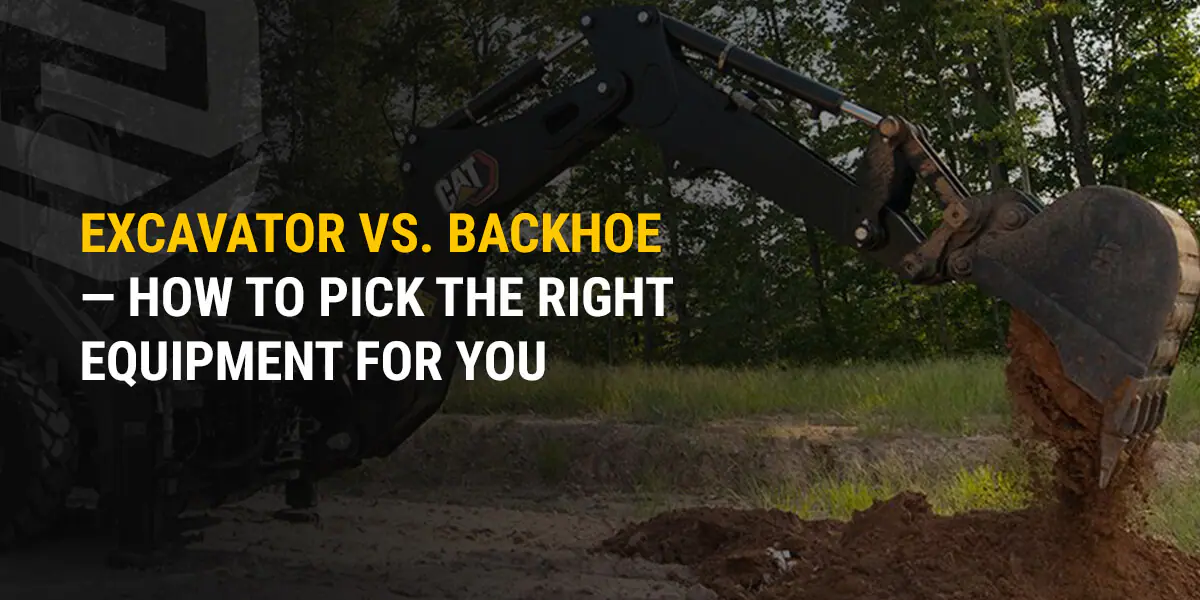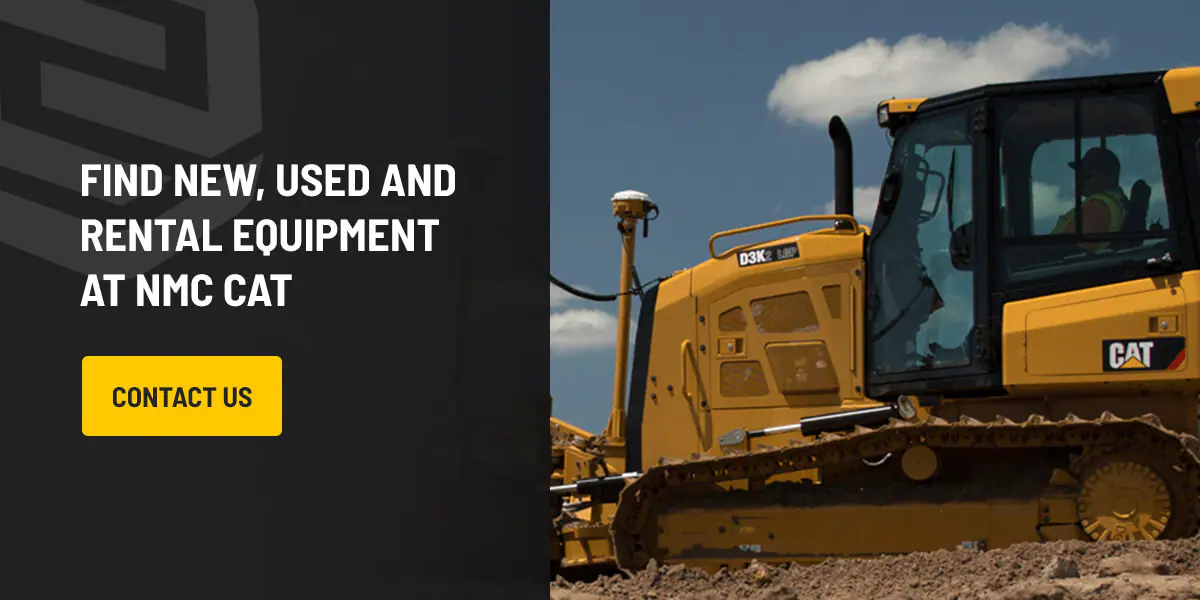
Excavator vs. Backhoe — How to Pick the Right Equipment for You
Category: Rental
What Is an Excavator?
Excavators may also be called diggers, mechanical shovels or track hoes when attached to tracks. An excavator is a kind of industrial digging machine with attachments like a digging bucket, chassis, boom or dipper that help it complete several different types of jobs and projects. Many excavators also come with additional tracks or wheels, which help them perform specific tasks on-site. For example, attaching a digging arm to an excavator can be used for heavier projects and jobs.
While some excavators may differ in their rotation capabilities, most have a cab that can rotate 360 degrees while sitting on top of its undercarriage. Excavators may also come in wheeled or compact variations, with a dozer blade on the opposite side of the digging arm.
With various possible attachments, excavators are often used for heavy drilling or demolition. For example, workers could attach a brush cutter to assist with forestry projects.
What Is a Backhoe?
Backhoes are excavation machines often made with a tractor base to support a digging bucket on the jointed arm. While the term may be confusing, as the digging bucket is usually located at the front of the machine, a backhoe tends to pull itself towards the earth rather than push. This gives it the name — backhoe.
Many backhoes also come with a front loader attachment on the opposite side. A seat inside the backhoe allows the machine to swivel 360 degrees, so the operator can face whatever side they want to use.
A backhoe also comes with the following parts:
- Boom: A segment of the backhoe’s arm attached to the tractor base.
- Dipper: A part of the backhoe that holds the digger bucket — also called the dipper stick.
- King-post: A pivot connecting the dipper and the boom.
- Attachments: Backhoes may come with hammers, rakes, breakers, drills or rippers.
Many workers detach the front loader and replace it with different plows, forklifts or plows to perform various jobs. A backhoe may also be used as a crane when the straps of an object are looped over the dipper.
Key Differences
Before choosing a backhoe or an excavator, you might want to explore the critical difference between each machine. Many people across industries find that there are three differences to note — size, versatility and rotation.
Size
Excavators tend to be larger and heavier than backhoes. While backhoes may also be better for farming, loading or snow removal jobs, an excavator can better handle demolition, mining, drilling or large-scale projects.
Versatility
Consider the differences in attachment options for the backhoe and excavator. The backhoe offers a broader selection, while an excavator may be limited to a few options. The backhoe can also be driven on roads and perform various tasks, while the excavator will need transportation and can only perform specific performance-designed tasks.
Rotation
The excavator and the backhoe have different rotation ranges, especially from an operator’s perspective. Excavators can rotate their chassis and arm together, while a backhoe arm may only pivot a little more than halfway around.
How to Choose Between an Excavator and a Backhoe
Choosing between an excavator and a backhoe is simple once you understand the size and scope of your project’s needs. From mobility needs to task specificity, understanding the mechanics of the job is the first step to choosing the right machinery. Here are seven areas that may help you choose between an excavator and a backhoe:
1. Project Size

Make sure you match your project’s scale to your machine’s size. For large-scale construction, demolition or excavation projects, you may want to use an excavator. Small-scale projects with moderate space may only require a backhoe.
2. Mobility
Think about how mobile you need the machinery to be. A backhoe can easily travel across job sites, while an excavator may require extra towing or trailers to move it from place to place. Use a backhoe if your job is spread out and requires tasks in separate areas.
3. Task Specificity
An excavator and a backhoe can both be used for digging purposes. However, you’ll want to look over other kinds of tasks to decide whether either machinery would suit the job. Think about what you need and what kind of attachments might be best. Depending on the functions, neither the backhoe nor the excavator may be the right choice.
4. Project Tasks
Consider your specific needs at each work site, as one or both machines may suit your tasks. Will you need the machine to dig, trench, pull, push or lift heavy objects? Depending on your answer, you may discover whether the backhoe or the excavator can do the job well. For example, a backhoe can perform high-power jobs like deep digging and heavy lifting. A mini excavator is better suited to repetitive tasks as it can rotate while remaining stationary.
5. Work Site Conditions
Your work site conditions may also tell you what kind of machine to choose. Finished work sites or soft terrains are great for excavators, while a backhoe may better handle rugged landscapes. You should also check whether your indoor or outdoor area has noise regulations, as excavators and backhoes may come with different noise levels.
Consider the maneuverability of your area as well. Excavators can move in smaller areas due to their controlled movement and minimal swing motion. They may also make a safer choice when working on hills or during winter or rainy days. A backhoe may cause a considerable amount of noise and may not be as easy to maneuver across smaller environments.
6. Travel Distance
The distance your machine needs to travel will also determine what to choose. Are you working in a single area? Or do you need to perform tasks across spread-out locations? Backhoes are capable of working across long distances and jobs, while an excavator requires a truck and a trailer to move it around. You may also want to check if your work site allows specific machines on-site, as some may restrict access to the weights of trucks, trailers or excavators.
7. Storage and Transportation
If the project lasts for several days, you may have to find on-site storage or consider transportation. While excavators may be easier to store due to their compact frames, a backhoe may need additional time and effort. Transporting an excavator takes time and appropriate trucks or trailers, while a backhoe can quickly move from place to place.
Find New, Used and Rental Equipment at NMC Cat
At NMC Cat, we offer reliable new, used and rental backhoe and excavator equipment to fit your project’s specific needs. Our company has over 80 years of experience in the industry and can help you find dependable equipment while quickly responding to your every need. With fast customer service and delivery to job sites, you can depend on NMC Cat to help you choose the correct excavator or backhoe for your job site. Contact NMC Cat today to speak to a representative, or call us at 800-628-6025.

